
Webmaster Peter McCarthy BEM
"HOW THE FLUTE WORKS" page 3
How to play the flute.
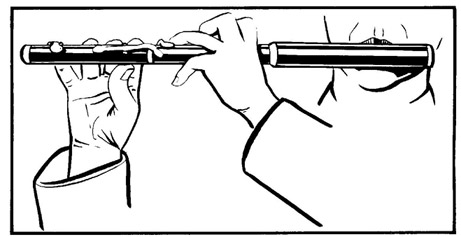
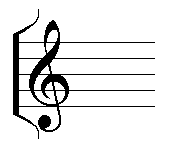

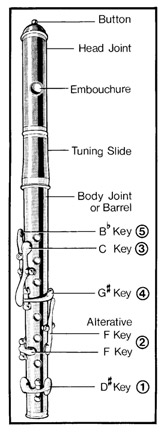
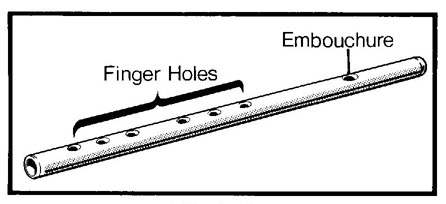
Producing Sound
The flute is a tube of metal, wood or ebonite with six finger holes along side and one larger mouth hole or embouchure in line with the six holes, but at one end of the tube. The end near the embouchure is sealed with a cork.
The flute is a tube of metal, wood or ebonite with six finger holes along side and one larger mouth hole or embouchure in line with the six holes, but at one end of the tube. The end near the embouchure is sealed with a cork.
The player blows a stream of air from the lips across the embouchure, which strikes the sharp edge of the other side and is split, being partly directed into the tube causing turbulence and setting up vibration in the column of air inside the tube
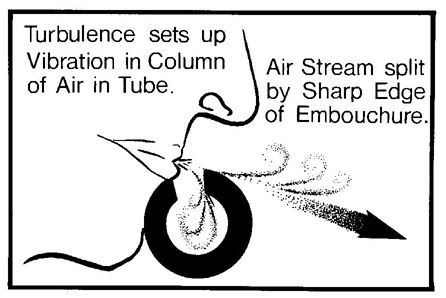
The longer the coloun of air, the slower the vibrations and so the lower. The sound the shorter the column of air, the faster the vibrations and so the higher the sound (this may easily be proved by looking inside a piano. The low or bass notes have long, thick, slowly vibrating strings whilst the high notes have short, thin strings which vibrate rapidly). This difference between high and low sounds is called pitch.
The player blows a stream of air from the lips across the embouchure, which strikes the sharp edge of the other side and is split, being partly directed into the tube causing turbulence and setting up vibration in the column of air inside the tube.The column of air inside the tube may be lengthened or shortened by covering or uncovering the finger holes along the side.
To illustrate this point further, the diagram of pan pipes shows different lengths of tube bound closely together, and a singly tube representing a flute. The single tube can produce all the sounds of the pan pipes by simplycovering or uncovering the finger holes as previously explained. By covering hole No.1 on the flute a short column of air is produced in the tube since the air will only vibrate between the embouchure and the nearest uncovered hole. So by covering each of the holes in turn from one to six the column of air in the tube is lengthened to produce lower sounds. With all six holes covered the whole column of air inside will vibrate.
The player blows a stream of air from the lips across the embouchure, which strikes the sharp edge of the other side and is split, being partly directed into the tube causing turbulence and setting up vibration in the column of air inside the tube.The column of air inside the tube may be lengthened or shortened by covering or uncovering the finger holes along the side.
To illustrate this point further, the diagram of pan pipes shows different lengths of tube bound closely together, and a singly tube representing a flute. The single tube can produce all the sounds of the pan pipes by simplycovering or uncovering the finger holes as previously explained. By covering hole No.1 on the flute a short column of air is produced in the tube since the air will only vibrate between the embouchure and the nearest uncovered hole. So by covering each of the holes in turn from one to six the column of air in the tube is lengthened to produce lower sounds. With all six holes covered the whole column of air inside will vibrate.
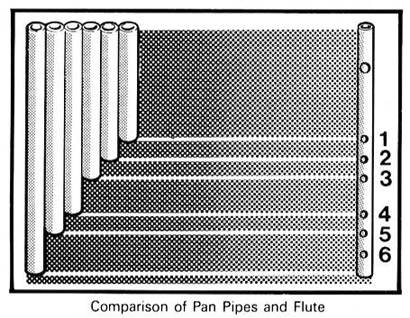
Overblowing
To increase the range of notes that can be played on the flute, a process known as overblowing may be used. By increasing the velocity of the air stream at the embouchure, the player can increase the speed of the vibrations in the tube to point where the column of air cannot respond fully. For example, if all six finger holes are covered to produce th lowest note, the same note may be reproduced eight notes higher, without rearranging the fingers. This is the most important aspect of wind instruments since it is this principle on which they are all based.
To increase the range of notes that can be played on the flute, a process known as overblowing may be used. By increasing the velocity of the air stream at the embouchure, the player can increase the speed of the vibrations in the tube to point where the column of air cannot respond fully. For example, if all six finger holes are covered to produce th lowest note, the same note may be reproduced eight notes higher, without rearranging the fingers. This is the most important aspect of wind instruments since it is this principle on which they are all based.



































